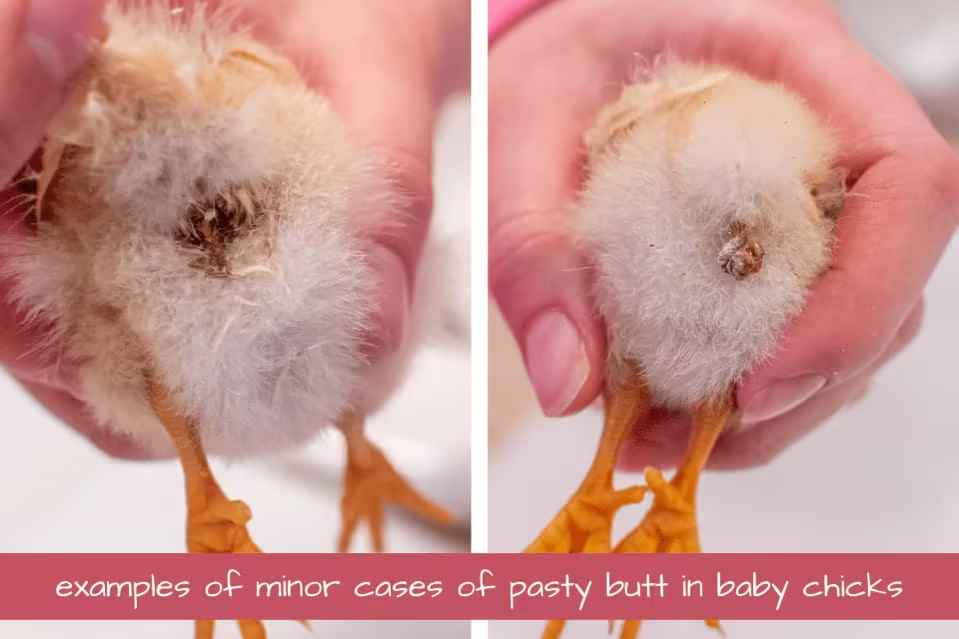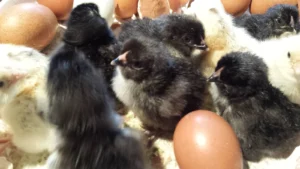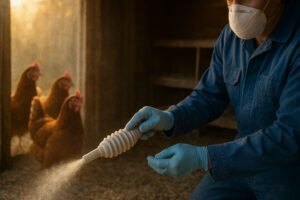Bringing home your first fluffy baby chicks is incredibly exciting, but discovering one has pasty butt in chicks can be alarming. Don’t panic—this is a very common and treatable issue for new chicks. This guide will provide a calm, step-by-step process to fix the problem and prevent it from happening again, ensuring your new flock of poultry gets a healthy start.
Important Note: This Guide is for Baby Chicks (Poultry) ONLY
The term sticky poop in chickens is sometimes searched for in the context of human infants. This article is exclusively about baby chickens (poultry). If you have concerns about a human baby, please consult a pediatrician or medical professional immediately.
What Exactly Is Pasty Butt?
The condition known as pasty butt in chicks is a symptom, not a disease. It occurs when a chick’s droppings stick to the delicate downy feathers around its vent (or cloaca), the opening where waste is expelled. These droppings dry into a hard plug, creating a blockage that can be fatal as it prevents the chick from pooping and can lead to a buildup of toxins and infection within the chick’s digestive system. The vent is the single external opening for the digestive, urinary, and reproductive tracts.
When it becomes obstructed, it can cause severe health problems, including sepsis, a life-threatening complication. It’s also important to distinguish the vent from the chick’s belly button or navel, which is located just below the vent. This spot, where the chick absorbed the yolk sac before hatching, must be allowed to dry and fall off naturally.
Understanding the seriousness of a pasty butt blockage highlights why quick action is so important. Now, let’s learn how to spot it before it becomes a major problem.
How to Identify Pasty Butt?
Early identification is key to a quick recovery. Make a simple “butt check” a part of your daily routine for the first one to two weeks, especially after they have arrived from the hatchery or via shipping.
Look for these visual and behavioral signs:
- Pasted-on Droppings: A distinct ball of dried droppings covering the vent. It may look small and hard or large and messy.
- Dirty, Matted Feathers: The soft, fluffy downy feathers around the rear end are dirty, stuck together, and wet.
- Lethargy and Distress: The chick may be squatting or sitting for long periods, not moving much, and not showing interest in food and water.
- Straining: You may notice the chick straining to pass droppings without success.
- Chirping and Crying: The chick may be vocalizing more than usual, indicating pain or discomfort from the blockage.
By making these quick, frequent checks a habit, you can catch pasty butt in chicks in its earliest stages. But what causes this issue in the first place?
What Causes Pasty Butt in Chicks?
Pasty butt in chicks is most commonly caused by stress, improper brooder temperature, and diet or hydration issues. Identifying the root cause is the first step in how to prevent pasty butt in chicks from happening again. Most causes stem from a combination of stress and an immature digestive system.
1. Improper Brooder Temperature
This is the number one cause. A chick’s ability to properly digest food is directly tied to the temperature of its environment.
- Too Cold (Chilling): Chilling causes a chick’s digestive system to slow down, leading to digestive upset and a messy pasty butt. The chick’s body will focus on staying warm, diverting energy away from proper digestion.
- Too Hot (Overheating): Overheating leads to dehydration, which results in sticky, messy droppings that lead to a blockage. The chick will also use up its energy reserves trying to cool down, leaving less for digestion.
2. Shipping and Environmental Stress
The stress of being shipped from a hatchery is a major contributor. The journey itself can be hard on a small chick’s system, and this is why pasty butt in chicks is so common in the first few days. Additionally, other stressors in the brooder can cause pasty butt.
- Environmental Stress: Overcrowding, loud noises, drafts, or the presence of pets can be very stressful for a young chick.
- Bullying: If a stronger chick is pecking at a weaker one, the stress can cause digestive upset.
3. Diet and Hydration Issues
Newly arrived chicks may struggle to find their water or food source initially, leading to dehydration. Additionally, a sudden change in feed or an unbalanced feed can shock their system.
- Water Source: Make sure the waterer is clearly visible and easy for the chicks to access. Avoid putting it in a hard-to-reach corner.
- Improper Feed: Ensure you’re using a quality chick starter feed that is specifically formulated for baby poultry. Never feed chicks treats, scratch grains, or adult chicken feed, as the nutrient imbalance and undigestible ingredients can cause immediate digestive problems.
Understanding these common causes allows you to take proactive steps to prevent pasty butt from ever becoming a problem. So, when it does happen, what’s the best way to handle it?
How to Treat Pasty Butt?
This is the most critical section for how to treat pasty butt in chicks. Be calm and gentle, and remember that patience is key.
Step 1: Gather Your Supplies
You will need a small bowl of warm water (not hot!), cotton swabs (Q-tips) or a soft paper towel, and a clean, dry towel. Optionally, you can have a small amount of petroleum jelly or coconut oil on hand.
Step 2: Hold the Chick Securely & Calmly
Gently cup the chick in your hand. The warmth of your hand will help it stay calm. You can also wrap the chick’s body in a small towel to help keep it warm and secure during the process.
Step 3: Moisten and Loosen the Blockage
This is the most crucial part. Use a Q-tip or a soft paper towel dipped in warm water to gently dab and moisten the dried poop. NEVER pull or pick at the dry plug, as you can tear the chick’s delicate skin and cause further injury. The goal is to soften the droppings until they fall away naturally with light pressure. This may take a few minutes. You may need to change out your water if it gets too cold.
Step 4: Gently Wipe the Debris Away
Once softened, the poop should wipe away easily with gentle dabbing. Continue until the vent is clean and clear of all debris.
Step 5: Dry the Chick Thoroughly
A wet chick can get chilled easily, which can lead to more health issues and another case of pasty butt. Gently pat the area dry with a clean, soft towel. If you have a hair dryer, you can use it on the lowest heat and fan settings, from a safe distance, to ensure the down is completely dry before you return the chick to the brooder.
Step 6: Apply a Protective Barrier (Optional)
Once the area is clean and dry, you can apply a tiny dab of petroleum jelly or coconut oil on the downy feathers around the vent. This creates a protective barrier that helps prevent more poop from sticking and can also soothe any irritated skin.
Step 7: Return the Chick to the Brooder Immediately
Place the chick back in the brooder and ensure it has access to the heat lamp to finish drying and recover from the ordeal. It’s essential that the chick warms up quickly to avoid becoming chilled, which can cause the problem to recur.
With the right technique, you can resolve pasty butt safely and effectively. Next, let’s explore how to create an environment that prevents this issue from happening in the first place.
How to Prevent Pasty Butt?
This is a proactive approach to keeping your chicks healthy.
Maintain Perfect Brooder Temperature
Use a thermometer to monitor the brooder temperature. The ideal temperature for the first week is 95°F, dropping by 5°F each week until they no longer need a heat lamp. You should also observe your chicks’ behavior as a “chick thermometer.”
- Too Hot: Chicks are spread out, lethargic, and panting. They may be avoiding the heat lamp.
- Too Cold: Chicks are huddled together in a tight, chirping ball under the heat lamp.
- Just Right: Chicks are spread out evenly throughout the brooder, eating, drinking, and exploring.
Ensure Proper Hydration and Nutrition
When chicks first arrive, dip each one’s beak in water to ensure they know where to drink. You can also add chick-specific electrolytes or probiotics to the water for the first few days to boost their gut health. This will help replenish the beneficial bacteria lost during shipping and stress.
Minimize Stress and Provide a Clean Brooder
Provide a clean, quiet brooder with plenty of space so the chicks do not feel crowded. Keep the brooder in a low-traffic area of your home, away from loud noises or curious pets. Use absorbent bedding like pine shavings and keep it clean and dry. Wet bedding can harbor bacteria that lead to digestive issues.
By focusing on these preventative measures, you can create a healthy start for your flock. But what if the problem keeps coming back, or you notice other symptoms?
Pasty Butt vs. Chick Diarrhea: What’s the Difference?
While they may look similar, it’s crucial to understand the difference. Pasty butt is a symptom of stress or poor environmental conditions, and it is generally not contagious. Diarrhea, on the other hand, is a symptom of a potential illness or disease, and it can be highly contagious.
- Pasty Butt: Sticky droppings are caused by the body’s reaction to stress or temperature. The chick’s poop may look normal but is simply sticking to its feathers.
- Diarrhea: The droppings are loose and watery. This can be a sign of a serious underlying condition like a bacterial infection or the parasitic disease Coccidiosis.
If you notice watery, bloody, or foamy droppings, especially in multiple chicks, it’s a major red flag. This indicates something more serious than simple pasty butt in chicks and may require different intervention.
Understanding the root cause is vital for a proper diagnosis. Now, let’s look at when you need to seek professional help.
When to Call the Vet
While pasty butt in chicks is often a simple problem to solve, there are times when it can be a sign of a more serious, underlying illness. You should consider contacting a veterinarian if:
- The condition is persistent: You are cleaning the chick’s vent daily, but the pasty butt in chicks keeps coming back despite your best efforts.
- Multiple chicks are affected: If more than a few baby chicks have pasty butt in chicks, it could indicate a larger issue in your brooder, such as an infection or disease.
- The chick is lethargic or showing other severe symptoms: If the chick is refusing to eat or drink, has bloody droppings, or is extremely weak, it may have a more serious illness that requires medical treatment.
- The vent area is red or inflamed: This can be a sign of an infection like Vent Gleet (cloacitis), a painful condition that requires different treatment. For more details on this serious condition, you can refer to this video: Vent Gleet in Chickens.
A veterinarian can diagnose and treat the underlying issue, giving your chick the best chance for a full recovery.
Pasty Butt FAQ: Answering Your Questions
Is apple cider vinegar good for chicks?
A tiny amount of raw, unpasteurized ACV in the water can be beneficial for the gut health of older chickens, but for new chicks, it’s best to stick to plain water or chick-specific electrolytes. It is not a direct treatment for pasty butt in chicks and can be too acidic for a young chick’s sensitive digestive system.
What does an Epsom salt bath do for chickens?
An Epsom salt bath is typically used for adult hens that are egg-bound. It is far too harsh and stressful for a tiny chick with pasty butt. Gentle cleaning with plain warm water is the correct and safe method.
How often should I check for pasty butt?
Check your chicks at least twice a day for the first week, and daily for the second week. Since pasty butt in chicks can become fatal so quickly, frequent checks are essential.
Can older chickens get a ‘pasty butt’?
While the term “pasty butt in chicks” refers specifically to this common chick issue, older chickens can get blockages or dirty vents due to illness, mites, or severe diarrhea. This should be treated as a sign of a different health problem, and the underlying cause should be addressed.
What about other home remedies?
Be cautious of home remedies you find online. For example, some suggest adding sugar to the water, but this can cause bacterial growth and digestive issues. Stick to simple, gentle methods like warm water and proper brooder management.
Conclusion: Healthy Chicks from Day One
Pasty butt in chicks is a common, stress– and temperature-related issue that is easily and safely treated with gentle, warm water cleaning. By keeping a watchful eye on your new flock and following these simple steps, you can confidently handle this common hiccup and ensure your chicks grow up healthy, happy, and strong.

Oladepo Babatunde is the founder of ChickenStarter.com. He is a backyard chicken keeper and educator who specializes in helping beginners raise healthy flocks, particularly in warm climates. His expertise comes from years of hands-on experience building coops, treating common chicken ailments, and solving flock management issues. His own happy hens are a testament to his methods, laying 25-30 eggs weekly.



